Ever feel your heart skip a beat at the roar of a chainsaw? That’s the rush Doom delivered when we dropped onto Phobos for the very first time.
Ever catch yourself humming Bobby Prince’s pounding riffs in the shower? You’re not alone.
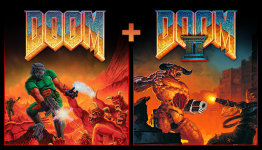
We’ve all been there, eyes widening at a cyberdemon’s glare or ducking into a secret alcove just to catch our breath. I remember when I first loaded the shareware disk late one night, flashlight under the blanket, and thought, “This is it. This is pure, unfiltered chaos.”
It wasn’t just a game. It was an initiation.
Slugging through pixelated corridors felt more real than any playground dare. We felt clever mapping every twist, proud when a rocket blast cleared our path, and guilty-pleasure thrilled by the gore we couldn’t look away from. Those nights glued to the screen shaped more than our high-score bragging rights. They shaped our style of play.
In the sections ahead, you’ll rediscover why Doom’s devilish design still grabs us by the nerves. We’ll revisit the secrets we missed, relive the boss fights that left us breathless, and see how those ’90s Hellscapes forged a legacy in every gamer’s soul. Ready to fire up that BFG of memories and blast through the nostalgia?
Let’s crank up the volume and step back into the darkness together.

Doom arrived on floppy disks and rewrote the rules. id Software’s founders John Carmack, John Romero and Sandy Petersen – teamed up to push 2.5D graphics into our homes. Carmack’s engine let walls rise at any angle. Romero hid secret switches and monster closets that still give us chills. Petersen added a horror flair that you felt in every map.
Shareware made Episode I free to copy and share. Overnight, living rooms became hellish battlefields. By 1994, DWANGO servers brought the first “deathmatch” online. In 1997, id released Doom’s source code under the GPL.
That move blew the doors open for modders everywhere. Fans created new levels, fresh monsters and wilder challenges. Even in 2019, Romero himself dropped Sigil, a paid fan episode built on the classic engine, proving Doom’s fire still burns hot.
Back In July 2021, a GeezeZone thread “Last video game played 2: Electric Boogaloo” lit up with Doom love. Some swore by Doom Eternal. Others bragged about dial-up voice-chat deathmatches back in the 90s. @Drac Morbis even launched a home-grown FPS inspired by those classic corridors.
These posts show that Doom’s spirit thrives among Geezers. Veterans chase that adrenaline rush. Newcomers want to know why Doom still tops the charts of nostalgia. Community-built mods and homemade shooters keep the legacy alive.
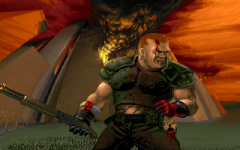
No name, no backstory, just pure grit and determination. That’s the Doomguy. He strides through halls on fire, shotgun in hand, never flinching. Players saw themselves in his helmeted stance and raw resolve. His silence spoke volumes: every explosion echoed our own heartbeat.
Years later, fans still rally behind his rage face meme, proof that this every-man hero left a permanent mark on gaming culture.
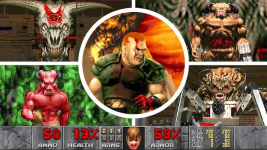
The Cyberdemon stomped into your path with rocket salvoes that turned walls into rubble. Defeating it felt like climbing Everest in a chainsaw suit. Barons of Hell surged at you in packs, roaring and clawing with blood-curdling ferocity. Then came the Spider Mastermind, an eight-legged nightmare with plasma cannons that screamed “final boss” the moment you saw it.
These encounters tested reflexes and nerves, giving bragging rights to anyone who survived on the toughest settings.
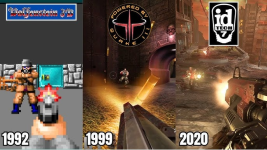
John Carmack built the engine that made every corridor feel real, even if it was 2.5D. John Romero shredded old level designs in favor of winding rooms and surprise ambushes. Sandy Petersen joined just before launch, injecting genuine horror chops that turned sterile labs into hellish mazes.
Together, they crafted more than a game; they created personalities that still resonate through fan art, convention panels and every new modder who credits those pioneers.
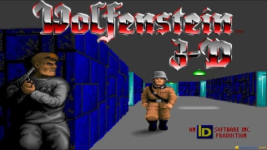
It paved the way for corridors you explored at breakneck speed. Doom borrowed that sense of urgency but cranked up the horror. Imagine trading rigid, right-angle halls for twisted labs dripping with goo. Where Wolfenstein felt brisk, Doom felt relentless.
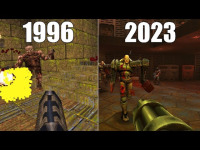
Walls could hang above your head. Enemies could lurk on multiple floors. The leap from 2.5D to full 3D felt like stepping from an attic into a skyscraper. Deathmatches shifted from early DWANGO lobbies to packed LAN tournaments.
Yet Doom’s raw simplicity still wins hearts. Quake might have sharper edges, but Doom’s corners hide bigger scares.
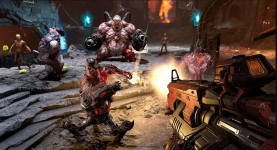
Image credit: Adrenaline
Upgrades, story scenes and new weapons add layers. Geezers rave about Eternal’s multiplayer thrills. They love that crushing feeling of a glory kill when life is hanging by a thread. Even decades later, the base blueprint stays intact: you versus hell on Earth.
Doom sits at the crossroads of these giants. It borrowed Wolfenstein’s momentum, inspired Quake’s arenas and set the stage for Eternal’s polished mayhem.
You might not know it, but the original E1M4 map sported a hidden swastika shape in its architecture.
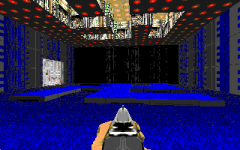
It was a cheeky nod to Wolfenstein 3D’s roots. Within days of release, a veteran player spotted it and word spread like wildfire. id Software quietly tweaked the level to remove that tribute, but the rumor lives on, proof that even boundary-pushing games sometimes circle back.
“Suite 666” Dental Office Backstory
Ever wondered why id’s cramped office felt straight out of a horror film?
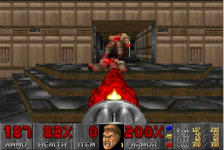
They nicknamed it “Suite 666” after eerie drilling noises from the dentist downstairs. Late-night playtests took on extra creep factor when a mysterious hum echoed through the walls. That accidental soundtrack may have influenced Doom’s claustrophobic atmosphere more than any design document.
Midnight Flashlight Shareware Sessions
Imagine slipping your floppy disk under a pillow, flashlight in hand, racing through Phobos at midnight.
That was the shareware era in a nutshell. No tutorials, no walkthroughs, just you, a dim beam and monsters lurking in every doorway. Those blanket-fort play sessions bonded early fans and sparked a do-it-yourself spirit that still fuels modding today.
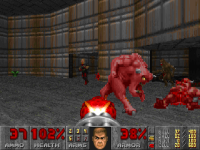
Doom Demos Sparked Speedrunning
Before YouTube or Twitch, Doom enthusiasts recorded “demo” files that replayed their runs. Share those tiny files on bulletin boards and you had instant bragging rights. Leaderboards formed around these demos by 1994, long before “speedrun” was a buzzword. It turned casual play into a competition—and laid the groundwork for modern speedrunning culture.
Bobby Prince’s Metal Inspirations
Listen closely to Doom’s soundtrack and you’ll hear riffs that echo Alice in Chains or Pantera.
Composer Bobby Prince borrowed thunderous drum patterns and distorted guitar tones. He never secured formal licensing, but those tracks cemented Doom’s heavy-metal edge. It’s one more example of creativity riding the line between homage and outright theft.
Dial-Up Voice Chat Deathmatches
Back in the day, some players rigged their modems to patch voice chat into online deathmatches.
Picture snarling monsters and then, over the hum of a dial-up connection, a friend’s taunt: “Watch your back!” It sounds clunky now, but at the time it felt like screaming through phone lines straight into Hell’s mouth. Those experiments foreshadowed today’s seamless multiplayer lobbies.
You wander through winding corridors, every echo promising a demon around the corner. Your ammo runs low, your health flirts with zero, yet you grip the shotgun tighter. That tension, being alone in the dark then finding a shotgun or a BFG 9000, turns vulnerability into exhilaration.
It is a power fantasy wrapped in horror and it hooks us every time.
Plasma rifles meeting snarling hellspawn. It is science fiction meeting horror in the most visceral way. Each weapon stands for human ingenuity in a demon’s den. When rockets blast through the air and pools of cyber oil spill across the floor, you remember that technology can both create and destroy. Doom paints that clash boldly and challenges players to wield science against superstition.
The WAD file format was an open invitation rather than an afterthought. Fans used DeHackEd to tweak enemy behavior. SIGIL and Alien Vendetta proved community levels could match id’s own. These mods did more than extend the game; they reinvented it. Each new map or monster became a love letter to Doom and a challenge to its legacy.
What started as a small network match gathering became QuakeCon, the world’s largest bring your own computer festival.
Doom brought players together in basements and dorm rooms. As modders swapped demo files, speed runners chased perfect times and rivals cheered every frag, a culture formed. Today thousands pack convention halls each year to relive that raw camaraderie.
It is more than a convention; it is a reunion for anyone who has ever felt the thrill of being the last marine standing.

Remember blowing your mind at Alien Vendetta’s twisted corridors?
Or the raw intensity of SIGIL I and II? These fan-made levels did more than add hours of play. They showed how creativity thrives when tools are in the hands of passionate players. Each custom map felt like a secret handshake among true Doom fans.
Doom Eternal Mod Scene
Fast forward to Doom Eternal and the mod hobby exploded. You can download a skin that turns every enemy into a neon monster. Or install a flamethrower mod that turns the double barrel shotgun into a jet of fire. In this forum, the “Ignore” mod has its own fan club. Players brag about tweaking enemy AI until every combat feels fresh and chaotic.
Installing Mods on Modern Ports
Getting these mods working is easier than you think. On Steam, open your game folder, drop the .wad or .pk3 file into the mods directory and launch with GZDoom. Console homebrew follows a similar path. Community hubs like Doomworld and ModDB offer step-by-step guides. No coding degree required; just download, drag and play.
Players shared tips on monster placement and lighting tricks. Reading their nostalgia-fueled notes takes you back to the thrill of cobbling together your own shooter in the late 90s.
Doom 64 followed in 1997 with new designs and fresh horrors that only Nintendo hardware could deliver. Fast forward to 2004 and Doom 3 reinvented the series as a survival horror nightmare. Then came the 2016 reboot, which stripped away the story fluff and doubled down on speed and brutality.
Doom Eternal arrived in 2020 with upgrade trees and expanded lore, proving that the core formula still packs a punch decades later.
Outside of games the Doom universe spread into novels and comics that explored backstory and characters nobody ever saw on screen. Two films released in 2005 and 2019 brought Doom’s demons to Hollywood, with mixed reviews but undeniable box office attention. Board games and action figures let fans hold a mini-plasma rifle or BFG 9000 in their hands. Apparel lines and collectible statuettes turned virtual weapons into real-world showpieces.
These spin offs didn’t just bank on nostalgia, they built a multimedia empire around that original thrill.
QuakeCon started as a small LAN party but today draws thousands under the banner “BYOC” bring your own computer to celebrate id’s legacy. Panels on speedrunning strategies share space with mod showcase tournaments. Online communities still host marathon sessions that recreate classic maps or race through fan episodes. Even in 2023 players still top leaderboards set in the 90s, shrinking time gaps by fractions of a second.
Every year those gatherings prove that Doom’s flame still lights up communities around the world.
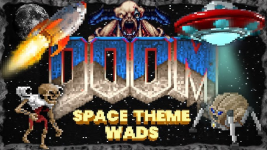
That flicker of the screen. That pounding MIDI track. That moment you stepped into pixelated hell and realized nothing else would ever hit quite the same. It’s not just nostalgia. It’s muscle memory, wired into the bones.
We’ve roamed the corridors of Mars, peeked into fan forums, marveled at the mods, and reloaded old memories with fresh appreciation. Doom wasn’t just a game, it was an awakening. A rite of passage. The chaos, the carnage, the joy of discovering something no school textbook could ever teach.
This isn’t about the pixels or the polygons. It’s about who you were when you first hit that spacebar. And maybe, who you still are when you fire it up again.
We’ve blasted demons, swapped cheat codes, and now we stand on the edge of the same fire-lit portal, hearts thumping like a double-barrel ready to go.
So, load up. Lock in. And never let the old-school flame burn out.
Ever catch yourself humming Bobby Prince’s pounding riffs in the shower? You’re not alone.

We’ve all been there, eyes widening at a cyberdemon’s glare or ducking into a secret alcove just to catch our breath. I remember when I first loaded the shareware disk late one night, flashlight under the blanket, and thought, “This is it. This is pure, unfiltered chaos.”
It wasn’t just a game. It was an initiation.
Slugging through pixelated corridors felt more real than any playground dare. We felt clever mapping every twist, proud when a rocket blast cleared our path, and guilty-pleasure thrilled by the gore we couldn’t look away from. Those nights glued to the screen shaped more than our high-score bragging rights. They shaped our style of play.
In the sections ahead, you’ll rediscover why Doom’s devilish design still grabs us by the nerves. We’ll revisit the secrets we missed, relive the boss fights that left us breathless, and see how those ’90s Hellscapes forged a legacy in every gamer’s soul. Ready to fire up that BFG of memories and blast through the nostalgia?
Let’s crank up the volume and step back into the darkness together.
Doom (1993 Video Game) Background and Facts
December 10, 1993 marked a turning point in gaming.
Doom arrived on floppy disks and rewrote the rules. id Software’s founders John Carmack, John Romero and Sandy Petersen – teamed up to push 2.5D graphics into our homes. Carmack’s engine let walls rise at any angle. Romero hid secret switches and monster closets that still give us chills. Petersen added a horror flair that you felt in every map.
Shareware made Episode I free to copy and share. Overnight, living rooms became hellish battlefields. By 1994, DWANGO servers brought the first “deathmatch” online. In 1997, id released Doom’s source code under the GPL.
That move blew the doors open for modders everywhere. Fans created new levels, fresh monsters and wilder challenges. Even in 2019, Romero himself dropped Sigil, a paid fan episode built on the classic engine, proving Doom’s fire still burns hot.
Back In July 2021, a GeezeZone thread “Last video game played 2: Electric Boogaloo” lit up with Doom love. Some swore by Doom Eternal. Others bragged about dial-up voice-chat deathmatches back in the 90s. @Drac Morbis even launched a home-grown FPS inspired by those classic corridors.
These posts show that Doom’s spirit thrives among Geezers. Veterans chase that adrenaline rush. Newcomers want to know why Doom still tops the charts of nostalgia. Community-built mods and homemade shooters keep the legacy alive.
Doom: Main Characters & Iconic Foes
The Doomguy (Space Marine)
Picture a lone marine dropped into Martian bases overrun by demons.
No name, no backstory, just pure grit and determination. That’s the Doomguy. He strides through halls on fire, shotgun in hand, never flinching. Players saw themselves in his helmeted stance and raw resolve. His silence spoke volumes: every explosion echoed our own heartbeat.
Years later, fans still rally behind his rage face meme, proof that this every-man hero left a permanent mark on gaming culture.
Major Demonic Adversaries
Every corner held a new terror.
The Cyberdemon stomped into your path with rocket salvoes that turned walls into rubble. Defeating it felt like climbing Everest in a chainsaw suit. Barons of Hell surged at you in packs, roaring and clawing with blood-curdling ferocity. Then came the Spider Mastermind, an eight-legged nightmare with plasma cannons that screamed “final boss” the moment you saw it.
These encounters tested reflexes and nerves, giving bragging rights to anyone who survived on the toughest settings.
id Software as a ‘Character Collective’
Behind the scenes, id’s founders read like a dream team.
John Carmack built the engine that made every corridor feel real, even if it was 2.5D. John Romero shredded old level designs in favor of winding rooms and surprise ambushes. Sandy Petersen joined just before launch, injecting genuine horror chops that turned sterile labs into hellish mazes.
Together, they crafted more than a game; they created personalities that still resonate through fan art, convention panels and every new modder who credits those pioneers.
Related Works & Comparisons
Wolfenstein 3D (1992)
Before demons and plasma rifles, there were Nazi soldiers and pistols in Wolfenstein 3D.
It paved the way for corridors you explored at breakneck speed. Doom borrowed that sense of urgency but cranked up the horror. Imagine trading rigid, right-angle halls for twisted labs dripping with goo. Where Wolfenstein felt brisk, Doom felt relentless.
Quake Series (1996–2005)
Quake pushed graphics into true 3D.
Walls could hang above your head. Enemies could lurk on multiple floors. The leap from 2.5D to full 3D felt like stepping from an attic into a skyscraper. Deathmatches shifted from early DWANGO lobbies to packed LAN tournaments.
Yet Doom’s raw simplicity still wins hearts. Quake might have sharper edges, but Doom’s corners hide bigger scares.
Doom Eternal (2020)
Fast forward to 2020 and Doom Eternal drops like a thunderclap.
Image credit: Adrenaline
Upgrades, story scenes and new weapons add layers. Geezers rave about Eternal’s multiplayer thrills. They love that crushing feeling of a glory kill when life is hanging by a thread. Even decades later, the base blueprint stays intact: you versus hell on Earth.
| Title | Release Years | Graphics | Multiplayer | Mod Scene |
|---|---|---|---|---|
| Wolfenstein 3D | 1992 | 2.5D, flat | None | Low |
| Doom | 1993 | 2.5D, billboards | DWANGO deathmatch | High |
| Quake Series | 1996–2005 | True 3D | LAN tournaments | Moderate |
| Doom Eternal | 2020 | 3D, modern | Online modes | Growing |
Doom sits at the crossroads of these giants. It borrowed Wolfenstein’s momentum, inspired Quake’s arenas and set the stage for Eternal’s polished mayhem.
Little-Known Facts About Doom Video Game
Swastika Tribute in E1M4You might not know it, but the original E1M4 map sported a hidden swastika shape in its architecture.

It was a cheeky nod to Wolfenstein 3D’s roots. Within days of release, a veteran player spotted it and word spread like wildfire. id Software quietly tweaked the level to remove that tribute, but the rumor lives on, proof that even boundary-pushing games sometimes circle back.
“Suite 666” Dental Office Backstory
Ever wondered why id’s cramped office felt straight out of a horror film?

They nicknamed it “Suite 666” after eerie drilling noises from the dentist downstairs. Late-night playtests took on extra creep factor when a mysterious hum echoed through the walls. That accidental soundtrack may have influenced Doom’s claustrophobic atmosphere more than any design document.
Midnight Flashlight Shareware Sessions
Imagine slipping your floppy disk under a pillow, flashlight in hand, racing through Phobos at midnight.
That was the shareware era in a nutshell. No tutorials, no walkthroughs, just you, a dim beam and monsters lurking in every doorway. Those blanket-fort play sessions bonded early fans and sparked a do-it-yourself spirit that still fuels modding today.

Doom Demos Sparked Speedrunning
Before YouTube or Twitch, Doom enthusiasts recorded “demo” files that replayed their runs. Share those tiny files on bulletin boards and you had instant bragging rights. Leaderboards formed around these demos by 1994, long before “speedrun” was a buzzword. It turned casual play into a competition—and laid the groundwork for modern speedrunning culture.
Bobby Prince’s Metal Inspirations
Listen closely to Doom’s soundtrack and you’ll hear riffs that echo Alice in Chains or Pantera.
Composer Bobby Prince borrowed thunderous drum patterns and distorted guitar tones. He never secured formal licensing, but those tracks cemented Doom’s heavy-metal edge. It’s one more example of creativity riding the line between homage and outright theft.
Dial-Up Voice Chat Deathmatches
Back in the day, some players rigged their modems to patch voice chat into online deathmatches.
A Deeper Look into Doom (1993)
Ever felt both terrified and unstoppable? That is Doom’s genius.You wander through winding corridors, every echo promising a demon around the corner. Your ammo runs low, your health flirts with zero, yet you grip the shotgun tighter. That tension, being alone in the dark then finding a shotgun or a BFG 9000, turns vulnerability into exhilaration.
It is a power fantasy wrapped in horror and it hooks us every time.
Plasma rifles meeting snarling hellspawn. It is science fiction meeting horror in the most visceral way. Each weapon stands for human ingenuity in a demon’s den. When rockets blast through the air and pools of cyber oil spill across the floor, you remember that technology can both create and destroy. Doom paints that clash boldly and challenges players to wield science against superstition.
The WAD file format was an open invitation rather than an afterthought. Fans used DeHackEd to tweak enemy behavior. SIGIL and Alien Vendetta proved community levels could match id’s own. These mods did more than extend the game; they reinvented it. Each new map or monster became a love letter to Doom and a challenge to its legacy.
What started as a small network match gathering became QuakeCon, the world’s largest bring your own computer festival.
Doom brought players together in basements and dorm rooms. As modders swapped demo files, speed runners chased perfect times and rivals cheered every frag, a culture formed. Today thousands pack convention halls each year to relive that raw camaraderie.
It is more than a convention; it is a reunion for anyone who has ever felt the thrill of being the last marine standing.

The Doom MODs that Made the Game Tick back in the '90s
Classic WADs You LovedRemember blowing your mind at Alien Vendetta’s twisted corridors?
Or the raw intensity of SIGIL I and II? These fan-made levels did more than add hours of play. They showed how creativity thrives when tools are in the hands of passionate players. Each custom map felt like a secret handshake among true Doom fans.
Doom Eternal Mod Scene
Fast forward to Doom Eternal and the mod hobby exploded. You can download a skin that turns every enemy into a neon monster. Or install a flamethrower mod that turns the double barrel shotgun into a jet of fire. In this forum, the “Ignore” mod has its own fan club. Players brag about tweaking enemy AI until every combat feels fresh and chaotic.
Installing Mods on Modern Ports
Getting these mods working is easier than you think. On Steam, open your game folder, drop the .wad or .pk3 file into the mods directory and launch with GZDoom. Console homebrew follows a similar path. Community hubs like Doomworld and ModDB offer step-by-step guides. No coding degree required; just download, drag and play.
Players shared tips on monster placement and lighting tricks. Reading their nostalgia-fueled notes takes you back to the thrill of cobbling together your own shooter in the late 90s.
The Legacy of Doom and How it Influenced the '90's Gaming
Doom II hit shelves in October 1994, picking up right where the first game left off. More levels, deadlier monsters and the same heart pounding action made it an instant classic.Doom 64 followed in 1997 with new designs and fresh horrors that only Nintendo hardware could deliver. Fast forward to 2004 and Doom 3 reinvented the series as a survival horror nightmare. Then came the 2016 reboot, which stripped away the story fluff and doubled down on speed and brutality.
Doom Eternal arrived in 2020 with upgrade trees and expanded lore, proving that the core formula still packs a punch decades later.
Outside of games the Doom universe spread into novels and comics that explored backstory and characters nobody ever saw on screen. Two films released in 2005 and 2019 brought Doom’s demons to Hollywood, with mixed reviews but undeniable box office attention. Board games and action figures let fans hold a mini-plasma rifle or BFG 9000 in their hands. Apparel lines and collectible statuettes turned virtual weapons into real-world showpieces.
These spin offs didn’t just bank on nostalgia, they built a multimedia empire around that original thrill.
QuakeCon started as a small LAN party but today draws thousands under the banner “BYOC” bring your own computer to celebrate id’s legacy. Panels on speedrunning strategies share space with mod showcase tournaments. Online communities still host marathon sessions that recreate classic maps or race through fan episodes. Even in 2023 players still top leaderboards set in the 90s, shrinking time gaps by fractions of a second.
Every year those gatherings prove that Doom’s flame still lights up communities around the world.

One Final Shot Before the Exit Door
Ever find yourself wishing you could relive that first time Doom lit up your CRT monitor?That flicker of the screen. That pounding MIDI track. That moment you stepped into pixelated hell and realized nothing else would ever hit quite the same. It’s not just nostalgia. It’s muscle memory, wired into the bones.
We’ve roamed the corridors of Mars, peeked into fan forums, marveled at the mods, and reloaded old memories with fresh appreciation. Doom wasn’t just a game, it was an awakening. A rite of passage. The chaos, the carnage, the joy of discovering something no school textbook could ever teach.
This isn’t about the pixels or the polygons. It’s about who you were when you first hit that spacebar. And maybe, who you still are when you fire it up again.
We’ve blasted demons, swapped cheat codes, and now we stand on the edge of the same fire-lit portal, hearts thumping like a double-barrel ready to go.
So, load up. Lock in. And never let the old-school flame burn out.

